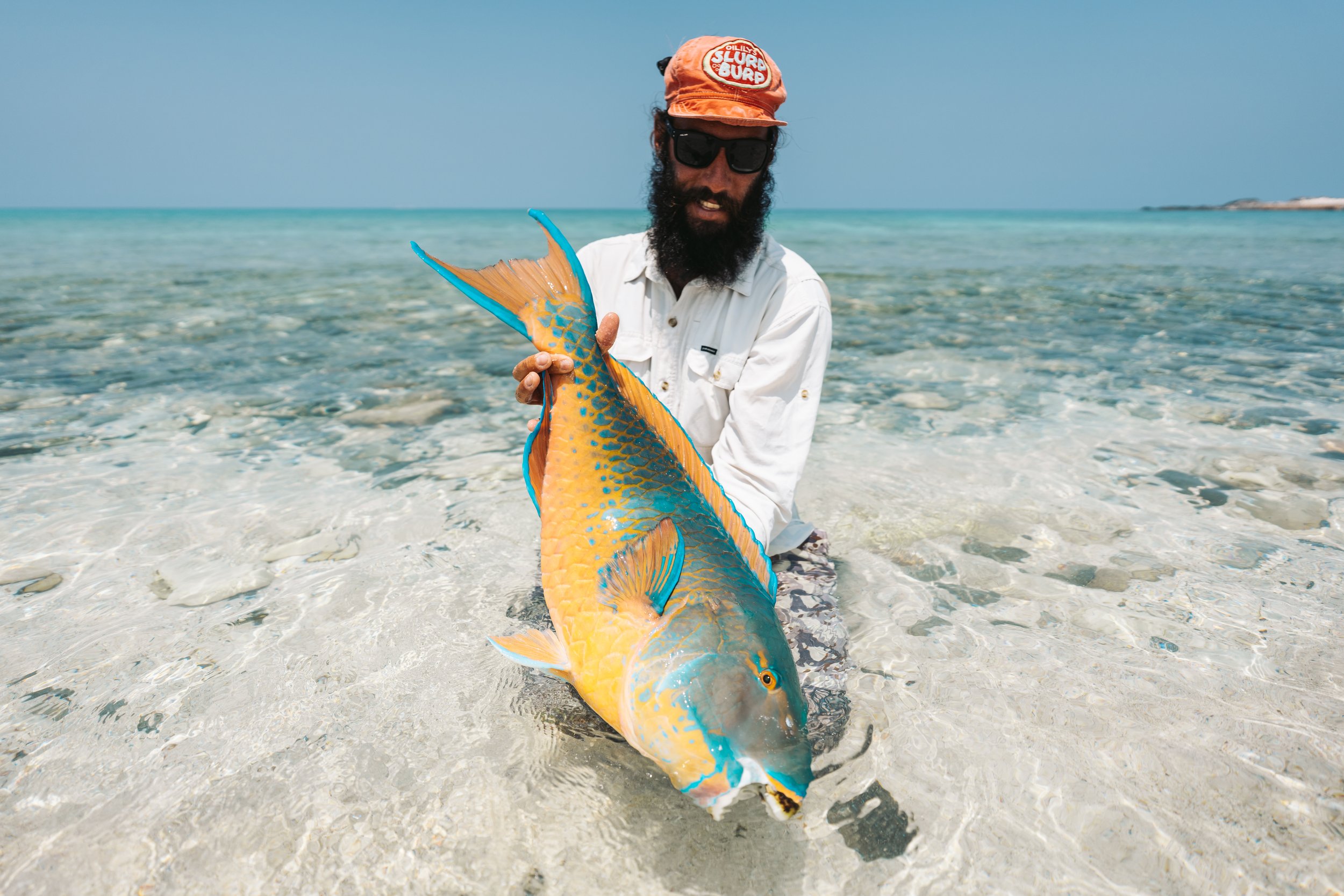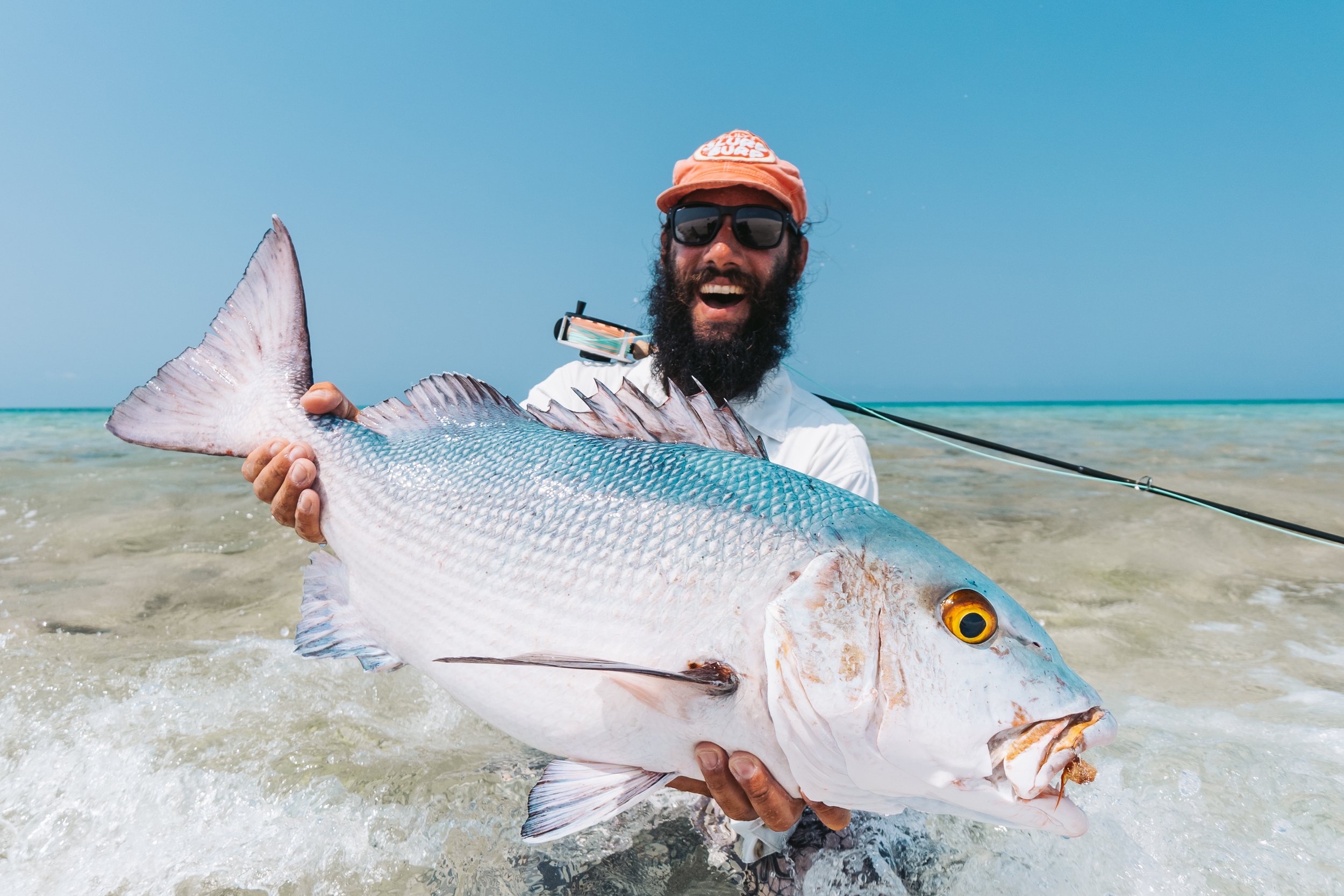Fly Fishing the Island of Socotra
If I look at my fishing philosophy and mentality, I realize how mere and insignificant I consider the size of the catch. What I would like to be more recognized by sport fishermen is that the most important thing is not the final result but the process to get there, which means many things, learning about the breath of water, learning how an ecosystem works, learning how to fish, and why not explore new waters and keep on learning new things by observing.
These days, fly fishing is over-saturated with any kind of content, but always about the same destinations, the same catches, and the same kind of things. I think the fault is the “pros,” who are not putting any effort into finding and showing something new. The whole market of sportfishing travel lies down in its comfort zone and rarely do we see something new. I believe this homologation will damage our sport soon because anglers will research the result and the social media photo, then the experience itself.
The catch is just the tip of the iceberg, to make it short, but there is tons of other stuff!
The History
I discovered Socotra back in 2010 when I was a kid, and nobody had fished there before. Since then, I’ve been in total love with this island, and this island represents a big slice of my life. What I found in 2010 on my first approach was just the best GT fishing in the world, which is still going on, but I didn’t have enough knowledge about fly fishing and not enough time to find out what I found later.
After my first four years there hosting, popping, and jigging groups and exploring new ground, the war in Yemen started in 2015, and I had to leave the island. During the following years, I had the chance to develop Sudan for Fly Fishing and explore Eritrea and Djibouti, so when Socotra opened again in 2019, I finally had the know-how to explore it on the fly.
In 2020, the year of Covid, I took a few good clients on an exploratory mission, and they had a good result. The most abundant fish were Parrotfish, but sea conditions were a bit rough, and I was busy guiding my Popping guys so that I couldn’t see the fishery with my eyes to any judgment. Then, Covid came, and everything shut down again. Till now…
Today
Having made tons of explorations before, I developed a certain pre-trip feeling, the feeling I had about this expedition was an extraordinary one. For this particular occasion, I invited a very good friend of mine. Without any doubt the best Fly Fisherman I know, moreover being a super tough guy that can walk 20 km a day with 0.75 lt of water and two boiled eggs as I can. Useless to say, we both were insanely excited about the trip, but what we found exceeded our expectations by far.
First of all, the fishing here is not the classic Flat Fishing. Still, it’s coastal fishing, where the coast is not a uniform system that varies from the white sandy beach to shallow water rocky bay, and on top, it’s very tidal, which means every spot can be extremely good or extremely bad at a different time of the day, not the best when you explore on foot a new ground. You have zero data to work with, so our only option was to walk a lot and look very carefully.
The Parrotfish
It’s hard to explain how our fishing evolved daily and how we understood the place. It’s something that took us days, probably only to scratch the surface.
On the first approach, we found tons of Parrotfish, big fish from 5 to 10 kg tailing in school, in the most variable environment, from the proper white sandy beach to rocky points with surfs.
We mainly focused on them in the first days, making many mistakes. We tried too hard on Parrotfish in dirty areas where we got constantly reefed. Still, on the other hand, we also landed some of them and found some spots where we saw Bohar Snapper and Green Jobfish from the beach, in tailing…
Bluefin Trevally has been a constant companion of our walking days but surprisingly very hard to catch. Typically, everywhere else in the world, Bluefin are pretty aggressive, and a good cast with a nine weight and small Gotcha or any small Shrimp pattern would do the job, but not here, which cost us some extra effort to figure out how to catch them, it can’t be easy!
Back to the main subject, the Parrotfish, as we started to stalk them, seemed pretty straightforward; however, the sea was a bit rough. The Parrotfish were pretty aggressive on a flexo crab well presented, but as the sea calmed down, they became harder and harder, always cacheable, but more and more moody. I think that a fish with mood and character is super interesting. The whole experience we had about chasing Parrotfish amazed me. The Parrotfish were happy and pretty dumb in the first days, but as the tide changed, they became way more complicated and moody, with some fish super spooky and others acting randomly. Some of them came to the beach after the fly, some had bitten the fly like a GT, while some followed many times like a Triggerfish, and some even came off and bit again. On top of that, as we started to target them only with flexo crab, we ended up casting everything to them, and we hooked them on any fly, including a small Gotcha, as long as it was well presented. Shortly, they acted excitingly and charmingly, and on top of that are just the most beautiful fish you can target on the fly!!
The Other Guys
We expected to meet some exciting sea inhabitants during our chasing of Parrotfish, but we found way more than what we expected.
The first morning I had two shots at Green Jobfish in shallow water with a small crab and 20 lb leader, expecting these fish to be super aggressive. I presented the fly aggressively, and after following for a few meters, both fish refused the fly, to my immense surprise.
A couple of hours later, I shot a big Bohar Snapper on the beach, again with my nine-weight rod and a small crab imitation. The fish came to my fly and followed it, and after 5 meters of following, he refused.
We understood something was wrong. It’s impossible to have multiple shots at these species and keep refusing a 0,33 mm leader and small fly, which means work on our approach and presentation. The day after we fished the same area, Johan caught some Parrot and lost some pretty big Yellow-spotted Trevally. I had shots at Sweetlips and another Bohar Snapper, which refused again, till, after many kilometers of walking, I saw a Snapper swimming at 2 meters from the beach. I just had time to jump down on my knees, not be spotted, put my fly in front of it and present it as if the fish was a spooky Bonefish. Finally, this fish took the fly. After an epic fight on a 0,33 mm leader, I managed to land this huge Bohar, one of the best catches of my life and I think a real trophy overall.
My Friend Johan, who came to help me land the fish, was over the moon with me. After the ritual photo shooting, we started to walk the beach together till we saw something strange, a Triggerfish tailing on a rocky bottom, but a peculiar Triggerfish, very, very dark coloration. Johan, a Triggerfish specialist, started to cast it, and the fish reacted very slowly till he got stuck in the bottom with his fly. Then I lent him my fly rod to keep casting to the fish. The action went on for 15 minutes, with the fish coming to the fly several times and never taking it, Johan changed the fly three times till the Trigger finally accepted it, and the fight started. The fish was pulling harder than any Sudanese Trigger we had ever fought. I had to jump in the water because the fish was looking for holes and coral, and while I tried to save the line from rocks, I could see the fish was something different. It was the mythological creature we chased for years, the ultra-rare “Blue Trigger,” which generally live deep between 10 to 50 meters.
As I grabbed the tail of the fish, I realized this was going to be the best fishing day of our life, the perfect combination of exploring new water, catching the world record Snapper on an eight-weight rod, and the first Blue Trigger ever caught on the fly, something that is just impossible to top, something that will remain in our memory forever.
Overall
With the exception of this memorable moment, there have been tons of others. The fishing has been so insane that it is hard to pick something specific because everything has been a highlight. We hooked a 5 kg Green Jobfish tailing on the beach. We hooked into Parrotfish on the sandy beach, Permit, Bonefish, and Milkfish from the shore, which came off by the end of the fighting. We hooked four different species of Parrotfish, we hooked an Emperor of 5 kg always on the same tiny Shrimp pattern, Big Eye Trevally, Blue Barred Trevally, Bluefin Trevally, Blue Triggers, Unicorn Fish, Three Spotted Pompano, Bohar Snapper, and Jobfish, and a rare style of Sweetlips, and Bonito, for a total of 22 significant species hooked. Still, it’s possible to reach over 25 species cause we saw GT, Titan Triggerfish, Bream, One Spot Snapper, and other species catchable on the fly.
Another highlight has been a shot I had from the beach of a 10 kg Spanish Mackerel that only followed my fly. That could have been something very different…
We didn’t invest time fishing from the boat with a sinking line and big Clouser Minnows, which I did years ago with great results, so that’s the plan for the next trip.
The Philosophy
I have to admit, I am very proud. Catching trophy fish on an eight-weight fly rod is just the tip of the iceberg. It has been ten years of insanely hard work and exploration to get there, and that’s the remarkable thing, not the fishing result itself.
This fishery is extraordinarily unique and special because all the fishing has to be done with an eight or nine-weight fly rod. The presentation has to be gentle and perfect every time, while everything has to be cut down to the simplest possible way to chase 25 different species, all on one rod, one reel, and one fly line. The flies become so crucial, approaching so many different environments and species with only one setup. The only variable thing is flies. You can’t use 40 different kinds of flies because there won’t be any time to change them between shots, so we found out that we could have done everything with three fly patterns, which makes everything intriguing at the highest possible level, 25 species on one rod, one leader and three flies.
Despite other fly fishing destinations being the best, in my opinion, there is nothing like walking on a remote and unknown beach where you can encounter more than 25 different species of sportfishing. You have to adapt your presentation to each of them. A real ultimate angler destination!
Photos by Robert Pljuscec & Johan Persson Friberg.
















